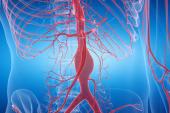New ESC Guidelines Merge PAD, Aortic Diseases Into Single Document
This novel structure recognizes that both are “part of one unique vascular system” requiring a holistic approach.

The European Society of Cardiology (ESC) has released new guidelines for the management of peripheral arterial disease and aortic disease—but with a twist. For the first time, these interrelated conditions are contained in a single, 163-page document.
Lucia Mazzolai, MD, PhD (Lausanne University Hospital, Switzerland), who co-chaired the guideline task force along with Jose F. Rodriguez-Palomares, MD, PhD (Vall d’Hebron Hospital Universitari, Barcelona, Spain), shared the thinking behind the change with attendees of the ESC Congress 2024 in London, England.
The “aorta and peripheral arteries are actually part of one unique vascular system,” said Mazzolai. She pointed out that disorders occurring in one of these arterial beds can often affect the other, and that the two share many of the same risk factors and management strategies.
“Therefore, the guidelines stress the fact that patients need to be holistically and globally assessed by a dedicated, experienced cardiovascular team at every single stage from prevention to diagnosis, to treatment, and to follow-up,” Mazzolai noted. As such, the authors aimed “to offer coordinated, homogenized, and clear guidance for everyday practice.”
Peripheral arterial and aortic diseases impact fully 15% of elderly people, she added. “However, they are still underdiagnosed and undertreated compared to coronary diseases.”
The guidelines, published online in the European Heart Journal, were endorsed by the European Association for Cardio-Thoracic Surgery, the European Reference Network on Rare Multisystemic Vascular Diseases, and the European Society of Vascular Medicine. Prior versions of the ESC guidelines for aortic and peripheral arterial disease came out in 2014 and 2017, respectively.
Guidelines are of no use to our patients if we don’t go home and implement them. Eva Prescott
For both conditions, highlights include new recommendations related to screening; lifestyle, physical activity, and patient education; and lipid-lowering therapy. “Cardiovascular risk factor control is crucial to prevent progression and complications,” the authors note. “Despite the benefit of medical therapy, lifestyle changes, healthy diet, abstinence from smoking, exercise/rehabilitation, and education are essential for effective management.”
Additionally, they say, “patient empowerment is essential to improve adherence and close/regular monitoring is essential to improve prognosis. Use of web- or app-based calculators for estimation of CV risk in the secondary prevention of atherosclerotic cardiovascular disease may aid patient motivation for lifestyle changes and adherence to medication.”
For PAD, in particular, there’s new guidance on exercise therapy, antithrombotics, interventional treatment in both asymptomatic and symptomatic patients, and management of chronic limb-threatening ischemia as well as carotid, subclavian, and renal artery disease. One key message, the paper notes, is that “atherosclerotic lower-extremity PAD is a chronic disease needing lifelong follow-up.”
For the aorta, there is new advice that covers wide ground for the diagnosis, treatment, and follow-up specific to aortic dissection, dilatation, and aneurysm as well as acute aortic syndromes more broadly; recommendations related to coarctation, bicuspid aortic valve-associated aortopathy, and traumatic aortic injury; and discussion of hereditary conditions. The latter includes guidance on patients with Turner, vascular Ehlers-Danlos, Marfan, and Loeys–Dietz syndromes.
Rodriguez-Palomares, who summed up the aortic disease guidelines for the ESC audience, said that one theme in that area is the need for standardized nomenclature and measurement. This is because when “we are dealing with patients with aortic diseases, most of our decisions are going to be made based on the diameter in a specific region of the aorta,” he explained, adding that standardization allows for “consistency in our communication” about size, location, and growth rate, factors that the paper notes determines whether monitoring is in order or if surgical/endovascular repair are needed.
To access all the document’s “algorithms, calculators, charts, and scores that can help you in your clinical practice,” Rodriguez-Palomares suggested downloading the ESC Pocket Guidelines app.
Eva Prescott, MD (Bispebjerg University Hospital, Copenhagen, Denmark), who co-moderated the ESC session, closed by reiterating the need for action. “Guidelines are of no use to our patients if we don’t go home and implement them,” she commented.
Caitlin E. Cox is News Editor of TCTMD and Associate Director, Editorial Content at the Cardiovascular Research Foundation. She produces the…
Read Full BioSources
Mazzolai L, Teixido-Tura G, Lanzi S, et al. 2024 ESC guidelines for the management of peripheral arterial and aortic diseases. Eur Heart J. 2024;Epub ahead or print.
Disclosures
- Mazzolai reports payment to her department/institution from Bayer, Amgen, Sankyo, Novartis, Pfizer, Sanofi Aventis, Sigvaris, and Otsuka as well as research funding to her department/institution from Novartis, Bayer, and Amgen.
- Rodriguez-Palomares reports payments from Pfizer, Takeda Pharmaceuticals, Amicus, and Janssen-Cilag; travel/meeting support from Takeda Pharmaceuticals, Novartis, and Pfizer; and payments to his department/institution from General Electric and Circle Cardiovascular Imaging.





Comments